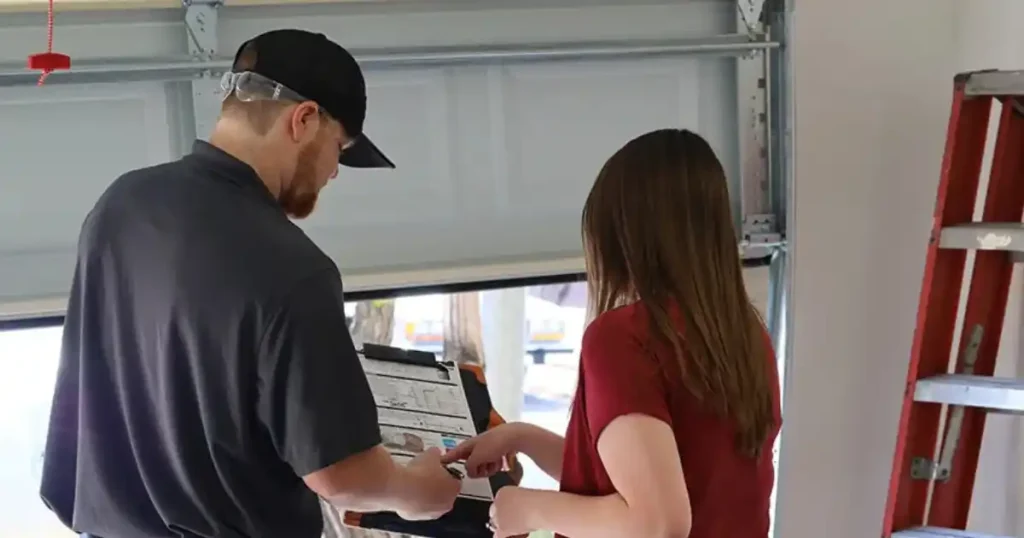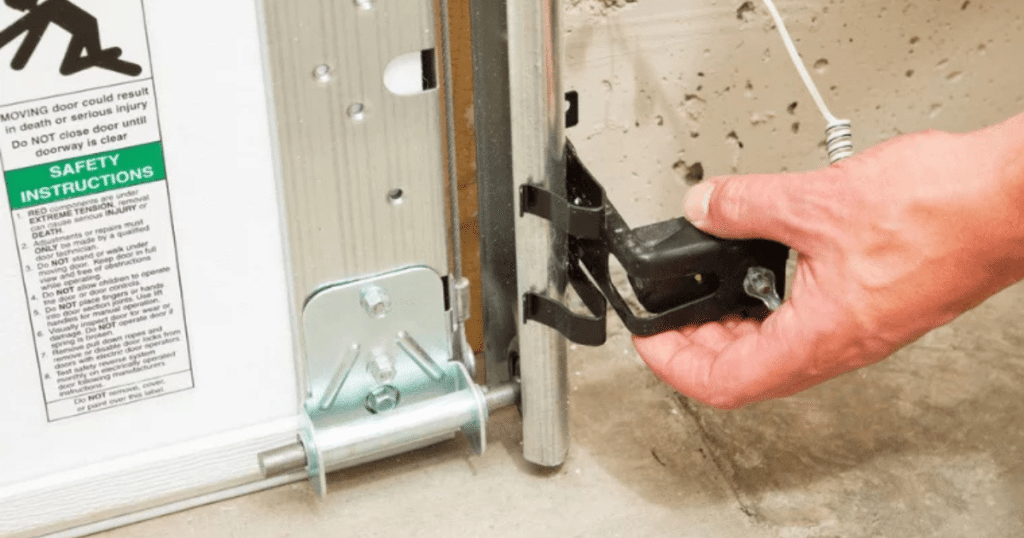If your garage door opener has started acting up—stalling, making strange grinding sounds, or refusing to respond—it may be time to consider a motor replacement. But before diving into how to change garage door motor, here’s the truth: this isn’t a do‑it‑yourself job.
Garage door motors are central to your door’s operation, tied directly to safety mechanisms, heavy‑duty lifting components, and sometimes even your home’s security. The process of removing and replacing a garage door motor is detailed, technical, and best left to certified technicians.

In this post, we’ll explain everything homeowners need to know about replacing a garage door motor, what signs to watch for, what the replacement process involves, how much it costs, and why hiring a professional is always the safer move.
What Does a Garage Door Motor Do?
The garage door motor powers the entire automatic opening and closing system. It’s located inside the garage door opener, usually mounted on the ceiling or wall. The motor drives a belt, chain, or screw system that moves the door along its tracks.
Without a working motor, your garage door becomes either a manual burden or, worse, completely unusable.
Most garage door motors are built to last 10–15 years, depending on how frequently you use them and how well they’re maintained. But eventually, parts wear out, internal components corrode, or the system fails. That’s when replacement becomes necessary.
Signs Your Garage Door Motor Needs Replacement
Motor issues often start with slightly slower movement and louder operation, but can escalate quickly. Here’s what to watch for:
Unusual Sounds
Grinding, humming, or screeching noises during operation can indicate internal wear or motor failure. If you’re hearing these sounds, it could point to problems with internal parts, like those outlined in this guide on garage door opener components.
Inconsistent Operation
Does your garage door only open halfway? Or does it reverse for no reason? These are signs the motor may not be regulating door movement properly.
Delayed Response
If pressing your remote or wall button results in a lag—or nothing at all—the motor’s logic board or internal gear system could be failing.
Stuck Door
If the door is completely unresponsive but power is reaching the unit, the motor may have burned out entirely.
What Happens During a Professional Motor Replacement?
Replacing a garage door motor isn’t just a swap-and-go process. It requires inspection, safe disassembly, and calibration. Here’s what a certified technician will do:
1. System Assessment
Before any tools come out, the technician checks your full opener system rails, springs, chains, trolleys, sensors, and wall controls to determine if the motor is the root issue.
For more on complete inspections, see Garage Door Repair Services.
2. Disconnect and Dismount
The motor is disconnected from the power supply, carefully unmounted from its bracket, and removed. Supporting components like the rail and drive system may be detached.
3. Motor Installation
The new motor is installed securely and aligned correctly with the opener rail. Wiring is redone, and new safety protocols (like backup batteries and light systems) are tested.
4. Calibration and Safety Testing
The technician adjusts force settings, travel limits, and remote pairing. Safety reversal systems and manual release mechanisms are also checked to meet modern safety standards. If adjustments seem off during operation, the LiftMaster adjustment guide offers insight into typical limit and force tuning issues
Which Motor Type Is Right for Your Garage Door?
Not all motors are created equal. Depending on your door’s weight, location, and insulation needs, you’ll want a motor that matches.
Chain-Drive Motors
- Most affordable
- Ideal for detached garages
- Louder operation
Belt-Drive Motors
- Quieter performance
- Great for attached garages or near bedrooms
- Slightly higher cost
Screw-Drive Motors
- Simple, fewer moving parts
- Requires regular maintenance
- Best for moderate climates
Jackshaft (Wall-Mounted) Motors
- Mounted beside the door
- Saves ceiling space
- Best for high-lift doors or garages with low headroom
Need help choosing the right type? Visit Garage Door Openers to explore your options.
How Much Does It Cost to Change a Garage Door Motor?

The cost of garage door motor replacement depends on several key factors:
- Motor type and features (e.g., intelligent connectivity, battery backup)
- Labor rates in your area
- Door configuration and weight
- Emergency vs scheduled service
Average Price Ranges:
- Basic motor replacement: $200–$350
- Smart motor systems: $400–$700
- Labor and installation: $100–$200
Why You Shouldn’t Change a Garage Door Motor Yourself
You might find online tutorials suggesting steps like “disconnect the rail,” “mount the new motor,” or “test the force settings.” But what they don’t show is the risk behind every step:
- Electrocution hazards from incorrect wiring
- Physical injury from heavy lifting and improper dismounting
- System misalignment that can damage your entire garage door
- Voided warranties if an unlicensed installation occurs
Even experienced DIYers often call a pro when dealing with openers. It’s one of the most delicate and safety-sensitive garage door repairs you can encounter.
When Is the Right Time to Replace, Not Repair?
Sometimes, minor motor issues can be fixed with a simple gear replacement or logic board reset. But replacement is usually the smarter choice if:
- The motor is over 10 years old
- You’ve had multiple service calls in a short time
- You want a quieter, smarter operation
- The motor model is obsolete or unsupported
If your current unit is outdated, consider a modern opener upgrade that enhances both convenience and reliability.
What to Expect from a Garage Door Motor Specialist
When hiring a technician, look for someone who:
- Offers free estimates and explains the process
- Has certification and insurance
- Installs motors that meet UL 325 safety standards
- Provides clear warranty information
For more on choosing the right technician, check out About Us to see how certified professionals handle your garage system from start to finish.
The Role of Safety Sensors in Motor Function
Today’s openers are built with safety sensors that detect obstructions and reverse door movement automatically. If your motor is being replaced, the technician will also:
- Check sensor alignment
- Test the reversing mechanism
- Inspect for frayed wires or loose brackets
Enhancing Your System During Motor Replacement
Motor replacement is also the perfect time to upgrade:
- Smart Wi-Fi openers for remote access
- LED lighting integrated into the housing
- Battery backup systems for power outages
- New keypads and remote controls
Discuss these options with your technician to make your system safer, more efficient, and future-ready.
Conclusion
If your garage door motor is failing, don’t wait for a total breakdown. While it may seem like a simple part, the motor plays a crucial role in your door’s performance and safety. Trying to replace it on your own may lead to injury, damage, or costly mistakes.
Instead, trust the experts. Grand River Garage Door offers fast, dependable motor replacement services performed by certified technicians who know how to get the job done right, the first time.
Book your inspection today and restore confidence in your home’s most-used entry point.
FAQs
How do I know my garage door motor needs replacement?
Loud grinding, humming, or screeching sounds, inconsistent opening and closing, or complete failure to operate are key signs your motor may be worn out. These symptoms usually indicate internal gear damage, electrical issues, or overall wear, meaning it’s time to consider a professional inspection or motor replacement.
Is it cheaper to repair or replace a garage door motor?
If your garage door motor is relatively new, under 10 years old, and the problem is minor, such as a loose wire or faulty sensor, repair may be more affordable. However, older motors or recurring problems usually make full replacement a better long-term investment in terms of performance and reliability.
How long does it take to replace a motor?
Most professional garage door motor replacements take between 1 and 2 hours, depending on the complexity of your opener system. Factors such as wiring condition, bracket compatibility, and the need to update sensors or remotes can influence the total time required to complete a safe, calibrated installation.
Can I change the motor myself?
No, and it’s not advised. Garage door motors involve high-voltage electrical work and tension-loaded mechanical systems. Attempting a DIY repair or installation can be extremely dangerous and may void your equipment warranty. It’s always best to call a licensed professional to ensure the job is done safely and correctly.
Will I need to replace my remote, too?
In most cases, no. Many new garage door motors are compatible with your existing remotes and wall-mounted openers. Technicians can often reprogram your current remote to work with the new unit, though some older systems may require an upgrade if they lack compatibility features or security standards.
Grand River Garage Door
4760 Simpson Rd, Owosso Township, MI 48867, United States
+15173259005





